Saturday October 23, 2004
The Guardian http://www.guardian.co.uk
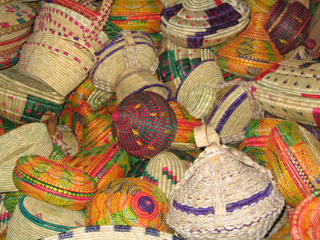
Moving on
Twenty years on from Live Aid, Bob Maddams discovers that the east
African country has outgrown its poverty-stricken image.
When Tony Blair was attending last week's Commission for Africa meeting
in Addis Ababa, the rumour went round that his plane had been sent on a
1,000-mile round trip to Nairobi to pick up his dinner. The story turned
out to be a myth, but it suited the popular image of Ethiopia as a
country continually beset by drought and famine. However, Live Aid and
those horrific newsreel images were 20 years ago, and any traveller who
has been there in the last few years will tell you that it is an
undiscovered jewel.
Most visitors come for the Historic Route, which includes Bahar Dar,
Gondar, Axum and Lalibela. History and legend merge into one another in
Ethiopia and nowhere more so than in Axum. History tells us that the
Axumite trading empire was known to the ancient Greeks and Egyptians,
and Axumite coins have been found in places as far away as India.
Legend, on the other hand, says that Axum was the home of the Queen of
Sheba, who travelled to Jerusalem and was seduced by King Solomon. She
returned to Axum where she bore a son, Menelik, who later travelled back
to Jerusalem to meet his father. When he left, he stole the Ark of the
Covenant from the Temple and took it back to his birthplace. It is said
to reside in the Church of St Mary of Zion to this day, locked away in
the Holy of Holies, which only deacons are allowed to enter.
Fact or fiction? You try convincing an Ethiopian that the story isn't
true. But no one can argue with the evidence of their own eyes, and
Axum's tall, monolithic stelae, or grave markers, stand testimony to a
once great empire.
Gondar, to the south, was the capital of Ethiopia dating from the 17th
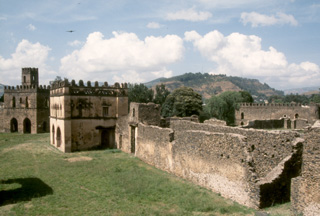
century. Known as Africa's Camelot, five impressive castles stand in a
Royal walled enclosure (right). Fasilidas' palace is the oldest and most
imposing, mixing Indian, Portuguese, Moorish and Axumite architectural
influences. My guide took great pride in telling me he escorted Michael
Palin around the enclosure when he visited Gondar as part of the BBC's
Pole To Pole series, and assured me that he was "a very nice man".
Bahar Dar is the closest that Ethiopia has to a garden city with its
wide boulevards flanked by rows of palm trees. It sits on the edge of
Lake Tana, which as well as being the source of the Blue Nile, is also
home to 26 islands with 36 monasteries, which can be explored by boat.
The monasteries don't appear to have been touched in hundreds of years
and the murals that adorn some of the interiors are breathtakingly
colourful.
Bahar Dar is also the jumping off point for the Blue Nile falls, the
second highest waterfall in Africa. Try to see them in the morning when
the sunlight creates rainbows in the mist: when I visited earlier this
year, three of us had the entire spectacle to ourselves.
For most people, the highlight of the Historic Route is the rock-hewn
churches of Lalibela. Designated as a world heritage site, they are
unofficially the eighth wonder of the world. The 11 churches, each
different in design, were carved from the living rock during the reign
of King Lalibela during the 13th century.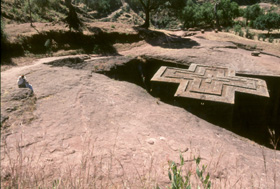
Legend again tells us that when the workers rested, angels continued the
work at night. Up to 30ft high, the deep holes that have been gouged out
of the cliff faces are linked by a network of carved trenches. Imagine a
religious version of Petra in a mountainous setting as remote as Machu
Picchu.
You are likely to share the site with monks and pilgrims, dressed in
their traditional white cotton shawls, or gabis, leaning on prayer
sticks in quiet contemplation or reading from an illuminated goat-skin
bible hundreds of years old.
Lalibela only comes alive during religious festivals when thousands of
Ethiopian Orthodox Christians flock to the churches. It may be an
architectural wonder to the rest of the world, but for them it remains a
spiritual headquarters.
The Victorian explorer Richard Burton was the first European to enter
Harar, which is the fourth holiest city in the Muslim world. He did so
in disguise, and had he been discovered he would have been executed on
the spot. Today, Harar is a far friendlier place. It is a completely
walled city, which you enter by one of the large wooden gates, and is
known for its markets, traditional round two-storey houses, intricate
and colourful basketware. Every evening, you can see the hyena man
feeding these ugly looking animals outside the city walls.
Although Ethiopia can't compete with Kenya and Tanzania when it comes to
big game, it boasts many national parks that are among the most
beautiful in east Africa. These include the Simien mountains (right),
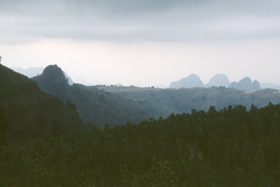
another world heritage site and a trekker's paradise with stunning vistas; the
Bale mountains national park; and the Nechisar national park, or White
Sands national park, which gets its name from the colour the midday sun
turns the savannah plains. They are all different but have something in
common that anyone who has been herded around in a convoy of buses on a
Kenya or Tanzania safari will appreciate - chances are you won't see
another soul.
But for real solitude head south to the Omo valley, home to the least
visited peoples on the African continent. These include the
lip-plate-wearing Mursi people and the animist Konso and the Hamer,
whose way of life has not changed for centuries.
Wherever you go in Ethiopia, there's little chance of avoiding Addis
Ababa. And why should you? Addis is one of Africa's most surprising and
cosmopolitan capital cities. Highlights include the National Museum
where you can see Lucy, the oldest, most complete skeleton of a hominid
- providing a link between man and ape - ever found. She was discovered
near Hader in north-east Ethiopia and named after the Beatles' Lucy In
The Sky With Diamonds, which was popular at the time.
The Institute of Ethiopian Studies, housed in a former palace of Haile
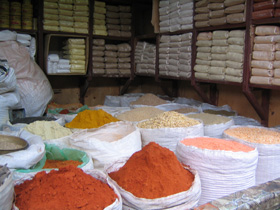
Selassie, is an ethnographic museum that brings the art and culture of
many of the peoples of Ethiopia together under one roof. And the
absolute must-see attraction is the guided tour of Mercato (right), reputedly
the largest open air market in Africa. On Saturdays, it seems as if the
whole country has descended on it, and everything imaginable is for sale.
Because Addis Ababa is the diplomatic capital of Africa a number of top
quality restaurants have sprung up to serve the needs of the visiting
diplomats and politicians. You will be faced with a choice of Chinese,
Indian, Thai, Korean, French, Italian, Armenian and even American-style
burger bars. Not to mention traditional Ethiopian restaurants where the
hot spicy main dishes, called wat, are served on top of injerra, the
traditional pancake that is served with
everything.
photos: Sam Packer
Addis also boasts the Sheraton Addis, which has been voted the most
luxurious hotel in Africa for the last four years, and which wouldn't
look out of place on the Las Vegas strip. But then that's Ethiopia for
you - it's not at all what you'd expect.
Guardian Unlimited © Guardian Newspapers Limited 2004
